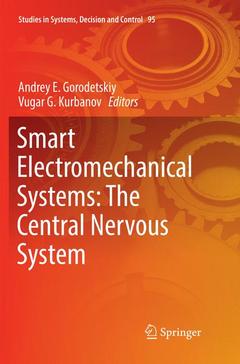Description
Smart Electromechanical Systems: The Central Nervous System, 1st ed. 2017
Studies in Systems, Decision and Control Series, Vol. 95
Language: English
Subjects for Smart Electromechanical Systems: The Central Nervous System:
Support: Print on demand
Description
/li>Contents
/li>Comment
/li>
This book describes approaches to solving the problems of developing the central nervous system of robots (CNSR) based on smart electromechanical systems (SEMS) modules, principles of construction of the various modules of the central nervous system and variants of mathematical software CNSR in control systems for intelligent robots. It presents the latest advances in theory and practice at the Russian Academy of Sciences. Developers of intelligent robots to solve modern problems in robotics are increasingly addressing the use of the bionic approach to create robots that mimic the complexity and adaptability of biological systems. These have smart electromechanical system (SEMS), which are used in various cyber-physical systems (CPhS), and allow the functions of calculation, control, communications, information storage, monitoring, measurement and control of parameters and environmental parameters to be integrated. The behavior of such systems is based on the information received from the central nervous system of the robot (CNSR) on the state of the environment and system state.
Recent advances in computer science, measuring and computing techniques have stimulated the practical realization of the CNSR, providing a fundamentally new approach to the methods and algorithms of formation of appropriate robot behavior.
Intelligent robots with CNSR occupy a special place among the highly efficient robotic systems with parallel structures and play an important role in modern automated industries, and this timely book is a valuable resource for specialists in the field of robotics and control, as well as for students majoring in ?Robots?, ?System analysis and management?, and ?Automation and control?.
Challenges Related To Development Of Central Nervous System Of A Robot On The Bases Of SEMS Modules.- Unified Logical Analysis in Robots’ CNS Based on N-tuple Algebra.- SEMS-Based Control in Locally Organized Hierarchical Structures of Robots Collectives.- Logical-Mathematical Model Of Decision Making In Central Nervous System SEMS.- Behavioral Decisions Of A Robot Based On Solving Of Systems Of Logical Equations.- Hierarchical Data Fusion Architecture for Unmanned Vehicles.- Automatic 3D Human Body Modelling.- Optoelectronic autocollimating video sensor for a mobile robot.- Method of constructing a system of optical sensors for mutual orientation of industrial robots for monitoring of the technosphere objects.- Adaptive Capture.- Controlled Ciliated Propulsion.- Flagella Propeller.- Linearized Model Of The Adaptive Platform With Parallel Structure.- Multiagent Approach To Control A Multisection Trunk-Type Manipulator.- Self-Learning Neural Network Control System For Physical Model With One Degree Of Freedom Of System OF Active Vibration Isolation And Pointing Of Payload Spacecraft.- Synthesis Of Control Of Hinged Bodies Relative Motion Ensuring Move Of Orientable Body To Necessary Absolute Position.- Automatic Control System Of Adaptive Capture.- Computer Simulation Of Automatic Control System Ciliated Propulsion.- Methodical Features of Acquisition of Independent Dynamic Equation of Relative Movement of One-degree of Freedom Manipulator on Movable Foundation as Control Object.
Discusses smart electromechanical systems (SEMS) and their application in cyber-physical systems (CPhS) based on information received from the central nervous system(CNS)
Presents the latest advances in theory and practice at the Russian Academy of Sciences
Demonstrates the development of methods for design and simulation based on the principles of bionics, adaptability, intelligence, and parallelism in information processing and computation
Includes supplementary material: sn.pub/extras
These books may interest you

Smart Electromechanical Systems 105.49 €

Smart Electromechanical Systems 105.49 €


